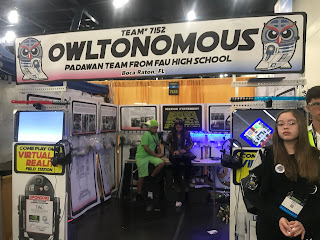Event 3: First Robotics Competition World Robotics Championships
During Week 3,
which happened to be during our Robotics and Art unit, I went to the First
Robotics Competition’s World Robotics Championships in Houston, Texas to cheer
on my brother’s robotics team. The competition was a true representation of how
Kelly describes the third culture – art and science coming together for each
team to create their masterpiece, filled with the “nerd” culture he describes,
but in the best way (Kelly).
The robots were
designed to be able to play a specific “game,” in which they had to be able to
lift cubes onto elevated surfaces to gain points, as well as climb about 2 feet
into the air. For the first 30 seconds of the match, the robot had to move
autonomously, based on computer coding done by the students. A driver was then
allowed to use a remote control to drive the robot around the field, scoring as
many points as possible. Robots were designed with various types of claw-like
features to grab cubes, “elevators” or arms to place the cubes on high or low
surfaces, and a number of climbing apparatuses used to hoist themselves into
the air.
 |
| A couple of unique pits |
Despite great
detail being placed into the functionality of each robot, the teams also
decorated their “pit” areas, where they had space to fix their robot between
matches and the robots themselves to represent their team. For example, my
brother’s robot was painted gold to reflect their school colors, while other
robots were adorned with flashing LED lights or pictures of the team icon. Benjamin
would not mind the way that these robots are created and decorated, because
each is very unique to the team that built it, with no two robots being copies
of each other (Benjamin). Though some robots held similarities in types of
wheels, climbing apparatuses, or cube intakes, each robot had a different
combination of systems they thought were best (and at any given time, any of
these systems may have been broken, adding to the competitive, creative
atmosphere). At any given time, a team’s pit may have resembled a Ford assembly
line, with one student milling a new part to replace one that broke, while
others attached new parts or ran through readiness checklists to ensure that
the robot was operating as well as possible (Vesna).
The field of
play was decorated in a “video game” theme, and teams adapted this theme into
their pits and robots as well. The students themselves dressed in all sorts of
costumes and team attire – some teams had mascots, while others had exciting
hats. My personal favorite was the team who all had crazy hairstyles,
spray-painted green to represent their school. The air of the championship was
competitive, but due to First’s value of “Coopertition,” a mixture of
cooperation and competition, teams were very friendly and willing to help one
another when parts broke or tools needed to be borrowed. This collaborative,
constructive environment allowed for better robots to be created as students
learned from different teams and got perspectives on how robotics is done in
different parts of the world.
 |
| Me in front of my brother's pit at World Championships (he is bending over) |
Works Cited
Benjamin,
Walter. “The Work of Art in the Age of Mechanical Reproduction.” Reading
Images, 2001, pp. 62–75., doi:10.1007/978-1-137-08886-4_7.
Kelly, Kevin.
"The third culture." Science 279.5353 (1998): 992-993.
Vesna, Victoria,
director. Robotics pt3. YouTube, 16 Apr. 2012,
youtu.be/wkP7oSZVkbg.



Comments
Post a Comment